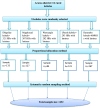Open defecation practice among households with latrines in rural communities of Ararso District, Somali Region, Eastern Ethiopia
- PMID: 38751595
- PMCID: PMC11094270
- DOI: 10.3389/fpubh.2024.1394351
Open defecation practice among households with latrines in rural communities of Ararso District, Somali Region, Eastern Ethiopia
Abstract
Background: Open defecation contributes to the spread of different feco-oral diseases. Therefore, access to a latrine is strongly recommended, as it considerably reduces the risks. Even though provision of latrine facilities alone does not guarantee the desired health benefits, they should be integrated with behavior change. In Ethiopia, efforts have been made to increase the coverage of latrine facilities. However, evidence on how consistently households use it is limited. Most prior studies focused on latrine utilization among households, and limited evidence is available about open defecation practices among households with latrines and associated factors. Thus, this study is critical for developing effective intervention approaches to prevent open defecation among households with latrines.
Objective: The aim of this study was to assess the open defecation practice and associated factors among households with latrines in rural communities of Ararso District, Somali Region, Eastern Ethiopia, 2023.
Method: A community-based, cross-sectional study design was employed among households with latrines in the district. A total of 632 households latrines were selected using a systematic sampling technique. Data were collected using a structured questionnaire and an observational checklist. The questionnaire was designed in KoboTool box, Humanitarian Response software, and the data were collected using the Kobo Collect version 2023.2.4 mobile application. The data were downloaded from the server in the Microsoft Excel format for data cleaning before being exported to STATA version 14 for analysis. Bivariate and multivariable analyses were employed to investigate the relationship between outcome and independent variables. Odd ratios with 95% confidence intervals were utilized to assess the association between the outcome and the predictor variables. A P-value of <0.05 was used as the threshold point for statistical significance.
Result: In this study, the prevalence of open defecation practice among households with latrines was 32.4% (95% CI: 28.1, 35.9). Sex of the household (AOR = 1.60, 95% CI: 1.06, 2.4), educational status (AOR = 2.40, 95% CI: 1.08, 5.53), family size (AOR = 1.62, 95% CI: 1.22, 2.78), the presence of under-5-year-old children in the house (AOR = 1.84, 95% CI: 1.19, 2.75), the need for latrine maintenance (AOR = 2.37.95% CI: 1.62, 3.48), current status of the latrine (AOR = 2.37, 95% CI: 1.62, 3.48), and latrine cleanness status (being unclean) (AOR = 1.91, 95% CI: 1.29, 2.81) were significantly associated with open defecation practice among households with latrine.
Conclusion: The study concluded that open defecation was significantly practiced by households with latrines. This revealed that the presence of a latrine alone was insufficient to considerably reduce open defecation. To alleviate this problem, the government and health workers, in collaboration with the health bureau, should promote frequent sanitation and hygiene education in the communities.
Keywords: Ararso District; Somali Region; households with latrines; open defecation; taboo.
Copyright © 2024 Ismail, Ibrahim, Abdi, Geremew, Mulugeta, Ayele and Cheru.
Conflict of interest statement
The authors declare that the research was conducted in the absence of any commercial or financial relationships that could be construed as a potential conflict of interest.
Figures



Similar articles
-
Having a latrine facility is not a guarantee for eliminating open defecation owing to socio-demographic and environmental factors: The case of Machakel district in Ethiopia.PLoS One. 2021 Sep 30;16(9):e0257813. doi: 10.1371/journal.pone.0257813. eCollection 2021. PLoS One. 2021. PMID: 34591873 Free PMC article.
-
Assessment of community led total sanitation and hygiene approach on improvement of latrine utilization in Laelay Maichew District, North Ethiopia. A comparative cross-sectional study.PLoS One. 2018 Sep 7;13(9):e0203458. doi: 10.1371/journal.pone.0203458. eCollection 2018. PLoS One. 2018. PMID: 30192803 Free PMC article.
-
A cross sectional study: latrine coverage and associated factors among rural communities in the District of Bahir Dar Zuria, Ethiopia.BMC Public Health. 2013 Feb 4;13:99. doi: 10.1186/1471-2458-13-99. BMC Public Health. 2013. PMID: 23374236 Free PMC article.
-
Household-level sanitation in Ethiopia and its influencing factors: a systematic review.BMC Public Health. 2022 Jul 29;22(1):1448. doi: 10.1186/s12889-022-13822-5. BMC Public Health. 2022. PMID: 35906616 Free PMC article.
-
Outcome evaluation of WASH intervention in rural households at Jawi district, Northwest Ethiopia: Mixed method design, goal based evaluation.Eval Program Plann. 2023 Jun;98:102283. doi: 10.1016/j.evalprogplan.2023.102283. Epub 2023 Apr 7. Eval Program Plann. 2023. PMID: 37084492 Review.
Cited by
-
Assessing fecal contamination from human and environmental sources using Escherichia coli as an indicator in rural eastern Ethiopian households-a cross-sectional study from the EXCAM project.Front Public Health. 2025 Jan 6;12:1484808. doi: 10.3389/fpubh.2024.1484808. eCollection 2024. Front Public Health. 2025. PMID: 39835307 Free PMC article.
-
Assessing fecal contamination from human and environmental sources using Escherichia coli as an indicator in rural eastern Ethiopian households - a study from the EXCAM project.medRxiv [Preprint]. 2024 Aug 22:2024.08.21.24312392. doi: 10.1101/2024.08.21.24312392. medRxiv. 2024. Update in: Front Public Health. 2025 Jan 06;12:1484808. doi: 10.3389/fpubh.2024.1484808. PMID: 39228739 Free PMC article. Updated. Preprint.
References
-
- Abathun T. Open Defecation Practice and Associated factors Among Households who have A Latrine in Rural Communities of Machakl District, East Gojjam Zone, Amhara Region, Northwest, Ethiopia: A Community Based Cross Sectional Study. (2020).
-
- Coffey D, Gupta A, Hathi P, Khurana N, Srivastav N, Vyas S, et al. . Open defecation: evidence from a new survey in rural north India. Econ Politi Weekly. 2014:43–55. Available online at: https://www.jstor.org/stable/2448070 - PMC - PubMed
-
- Bathija GV, Sarvar R. Defecation practices in residents of urban slums and rural areas of hubballi, Dharwad: a cross sectional study. Int J Community Med Public Health. (2017) 4:724–8. 10.18203/2394-6040.ijcmph20170747 - DOI
MeSH terms
LinkOut - more resources
Full Text Sources
Medical

